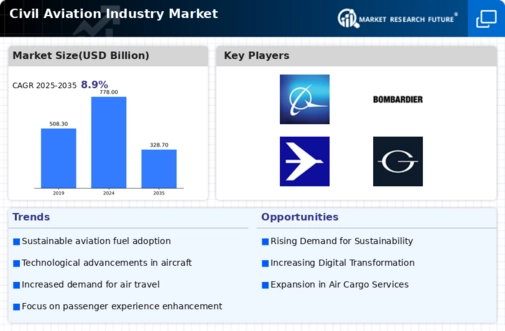Market Trends and Projections
The Global Civil Aviation Industry Market is projected to experience fluctuations in growth rates, with a forecasted CAGR of -7.53% from 2025 to 2035. This decline may be attributed to various factors, including economic uncertainties and evolving consumer preferences. Despite the anticipated challenges, the market is expected to maintain a valuation of 328.7 USD Billion by 2035. These trends indicate a complex landscape for stakeholders, necessitating strategic adaptations to navigate potential downturns while capitalizing on emerging opportunities. The Global Civil Aviation Industry Market remains a dynamic arena, where adaptability and foresight will be crucial for sustained success.
Expansion of Low-Cost Carriers
The rise of low-cost carriers (LCCs) is reshaping the Global Civil Aviation Industry Market by making air travel more accessible to a broader audience. LCCs, such as Ryanair and Southwest Airlines, have revolutionized pricing models, enabling consumers to travel at lower costs. This expansion is particularly evident in regions with previously limited air travel options, fostering competition and driving down fares. As a result, the Global Civil Aviation Industry Market is experiencing a democratization of air travel, with increased passenger volumes contributing to overall market growth. The presence of LCCs is likely to continue influencing consumer behavior and shaping industry dynamics.
Rising Global Air Travel Demand
The Global Civil Aviation Industry Market experiences a notable surge in air travel demand, driven by increasing disposable incomes and a growing middle class in emerging economies. In 2024, the market is valued at approximately 778.0 USD Billion, reflecting a robust recovery trajectory. This demand is particularly evident in regions such as Asia-Pacific, where air passenger traffic is projected to grow significantly. Airlines are expanding their fleets and routes to accommodate this influx, indicating a strong correlation between economic growth and air travel. As a result, the Global Civil Aviation Industry Market is poised for sustained growth, with airlines adapting to meet evolving consumer preferences.
Increased Focus on Sustainability
The Global Civil Aviation Industry Market is witnessing a paradigm shift towards sustainability, driven by heightened awareness of environmental issues. Airlines are increasingly adopting sustainable aviation fuels and implementing carbon offset programs to mitigate their carbon footprints. This trend is supported by regulatory frameworks and consumer preferences favoring eco-friendly travel options. For instance, several airlines have committed to achieving net-zero emissions by 2050, reflecting a long-term vision for sustainability. As the industry evolves, the integration of sustainable practices is likely to become a defining characteristic of the Global Civil Aviation Industry Market, influencing operational strategies and investment decisions.
Government Initiatives and Investments
Government policies and investments are crucial drivers of the Global Civil Aviation Industry Market. Many countries are prioritizing infrastructure development, including airport expansions and modernization projects, to accommodate rising passenger numbers. For example, significant funding has been allocated for airport upgrades in regions like the Middle East and Asia, enhancing connectivity and operational capacity. These initiatives not only stimulate economic growth but also attract foreign investment in the aviation sector. As a result, the Global Civil Aviation Industry Market is expected to benefit from these strategic government actions, fostering a conducive environment for growth and innovation.
Technological Advancements in Aviation
Technological innovations play a pivotal role in shaping the Global Civil Aviation Industry Market. Advancements in aircraft design, fuel efficiency, and navigation systems contribute to enhanced operational efficiency and reduced environmental impact. For instance, the introduction of next-generation aircraft, such as the Boeing 787 and Airbus A350, showcases significant improvements in fuel consumption and passenger comfort. These innovations not only attract environmentally conscious travelers but also align with global sustainability goals. Consequently, the Global Civil Aviation Industry Market is likely to witness increased investments in technology, further driving growth and competitiveness in the sector.















Leave a Comment